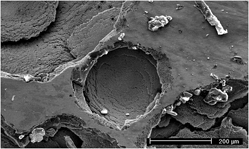Crossref Citations
This article has been cited by the following publications. This list is generated based on data provided by
Crossref.
Cui, Kaixuan
Liu, Liqiang
and
Sun, Mingjie
2017.
Study on improving the heat storage property of Ba(OH)2·8H2O with paraffin.
Materials Research Express,
Vol. 4,
Issue. 12,
p.
125502.
Cao, X.Y.
Zhu, P.
Liu, T.G.
Lu, Y.H.
and
Shoji, T.
2017.
Microstructure and electrochemical behavior of stainless steel weld overlay cladding exposed to post weld heat treatment.
Journal of Materials Research,
Vol. 32,
Issue. 4,
p.
852.
Zhu, Ping
Cao, Xinyuan
Wang, Wei
Zhao, Jiancang
Lu, Yonghao
and
Shoji, Tetsuo
2017.
An investigation on microstructure and pitting corrosion behavior of 316L stainless steel weld joint.
Journal of Materials Research,
Vol. 32,
Issue. 20,
p.
3904.
Cardoso, Jorge Luiz
Mandel, Marcel
Krüger, Lutz
Herculano, Luís Flávio Gaspar
Lima Neto, Pedro de
and
Silva, Marcelo José Gomes da
2019.
Corrosion Behavior of Austenitic Stainless Steels in CO2-Saturated Synthetic Oil Field Formation Water.
Materials Research,
Vol. 22,
Issue. 4,
Avila, Breno Mendes Rabelo
Itman Filho, André
Altoé, João Alberto Fioresi
Mazini, Jaqueline Polezi
and
Oliveira, Pedro Gabriel Bonella de
2020.
Cold Deformation and Hardness on Superaustenitic Stainless Steel: Evaluation Methods.
Materials Research,
Vol. 23,
Issue. 4,
Likhanova, Natalya V
Cruz Castañeda, Miguel A
Arellanes-Lozada, Paulina
Olivares-Xometl, Octavio
Lijanova, Irina
and
Arriola-Morales, J
2021.
Corrosion resistance of the dissimilar alloy AL6XN-Inconel 718 in 0.5 M NaCl.
Materials Research Express,
Vol. 8,
Issue. 8,
p.
086509.
Slepski, Pawel
Gerengi, Husnu
Gece, Gökhan
Kaya, Ertuğrul
Rizvi, Marziya
and
Szociński, Michal
2021.
Sustainable Corrosion Inhibitors I: Fundamentals, Methodologies, and Industrial Applications.
Vol. 1403,
Issue. ,
p.
61.
Ribeiro dos Santos, Julianne
Gaspar Herculano, Luís Flávio
Cardoso, Jorge Luiz
and
Gomes da Silva, Marcelo José
2022.
Analysis of the electrochemical behavior of a super ferritic stainless steel model alloy containing 0.07 % boron.
International Journal of Materials Research,
Vol. 113,
Issue. 4,
p.
327.
Verhoeven, Brent
Nagels, Maarten
Van Aken, Pieter
Gaggiano, Roberto
Rossi, Barbara
Bogaerts, Walter
and
Dewil, Raf
2023.
A new methodology to efficiently test pitting corrosion: design of a 3D-printed sample holder to avoid the occurrence of crevice corrosion in chemically aggressive media.
Journal of Applied Electrochemistry,
Vol. 53,
Issue. 1,
p.
167.
Hwang, Hyun-Kyu
and
Kim, Seong-Jong
2023.
Electrochemical Properties of Super Austenite Stainless Steel with Temperature in a Green Death Solution.
Coatings,
Vol. 13,
Issue. 1,
p.
130.
Zengin, Esra
Ahlatci, Hayrettin
and
Zengin, Hüseyin
2023.
Production and characterization of AISI 316L stainless steel matrix hybrid composites reinforced with boron carbide and carbon nanotubes.
Journal of Composite Materials,
Vol. 57,
Issue. 6,
p.
1121.
Hwang, Hyun-Kyu
and
Kim, Seong-Jong
2023.
Optimization of Electropolishing Process Using Taguchi Robust Design for UNS N08367 in a Mixed Solution of Sulfuric Acid and Phosphoric Acid.
Coatings,
Vol. 13,
Issue. 2,
p.
312.
Chuaiphan, Wichan
Kaewsakul, Nut
and
Nansaarng, Santirat
2024.
Roles of hydrogen in shielding gas for compensate heat input on dissimilar joints of stainless steel series 200 between AISI 201LN and 214 by GTAW.
Journal of Alloys and Metallurgical Systems,
Vol. 5,
Issue. ,
p.
100052.
Hernández, M.
Ambriz, R.R.
Amrouche, A.
and
Jaramillo, D.
2024.
Mechanical behavior of dissimilar AL6XN-IN718 welded joint obtained by cold metal transfer.
Journal of Materials Research and Technology,
Vol. 30,
Issue. ,
p.
7384.
